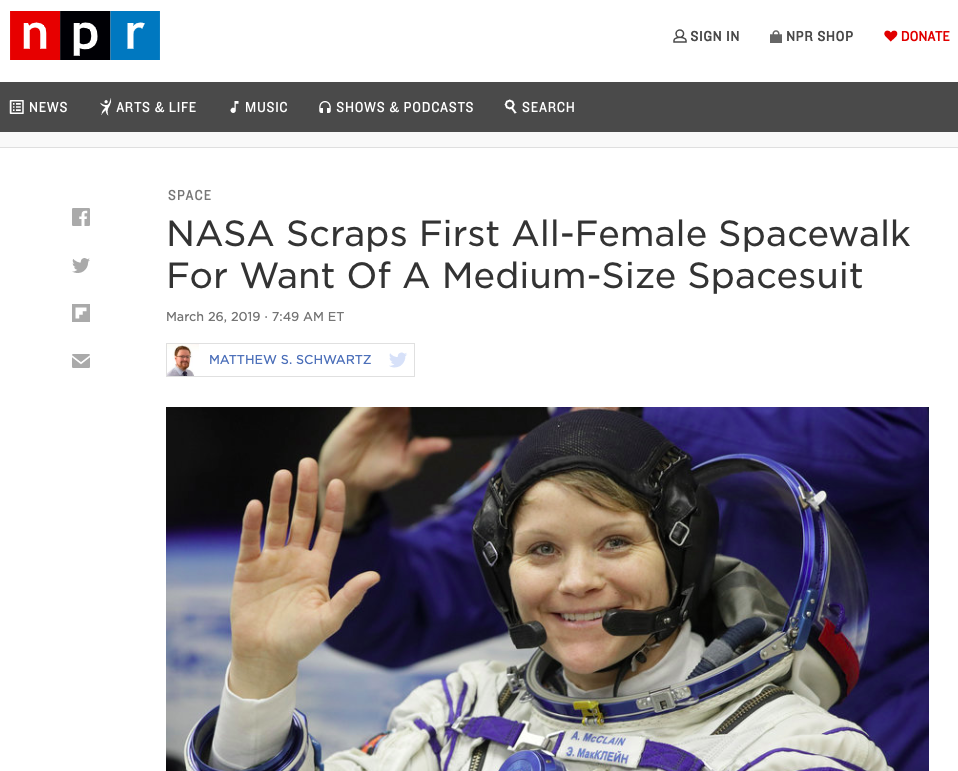
By Sarah Moss, MPA | LinkedIn | Twitter
What I am watching: The Right Stuff, about the early years of the U.S. space program
What I am reading / listening to: Creative Quest by Questlove / The Roots
What I am working on: Rewriting lyrics to pop songs for fun localgov and nonprofit clients to sing about policy issues on video… because our four-page budget recommendation letter makes my heart sing, but not necessarily everyone else’s.
My three-year-old nephew is obsessed with outer space. He can identify planets in photos. He will rattle off the moons of Jupiter. And he can explain the giant impact hypothesis with hand gestures and explosion noises. (I can’t, so read this NASA article, which is equally explanatory yet less adorable.) My nephew loves watching NASA livestream videos online with his parents. Earlier this year, when NASA announced its first all-woman spacewalk, I was excited to share it with my family. And then…

WOMP WOMP. Cue “Nephew’s first lesson in institutional discrimination.”
This NASA news echoed stories I heard when interviewing fire department employees, both firefighters and civilian staff, as I created a strategic plan for inclusion and diversity. They told me firefighters tried on bunking gear (protective pants and coats) before the department ordered the gear. But the sizes available for try on were limited, so employees with smaller bodies (mostly women) and employees with larger bodies (mostly men) had to take time to drive somewhere else for a special fitting. These employees were frustrated with the time suck and sometimes felt singled out and embarrassed. I also learned the department did not procure maternity uniforms or other clothing, even though the department hired its first women firefighters in the 1980s and likely hired women on civilian staff even earlier. Oh. My. Stars. Also in 2018, the department was not ordering fitted cuts for clothing that often better suit women’s bodies. After seeing these purchasing decisions up close — and the messages they sent to employees — I’m not surprised that nationally only 4% of firefighters are women.
There is good news! You can start purchasing practices that are respectful and inclusive of our localgov colleagues and residents with insightful questioning, innovative thinking, and Internet research.
Tips to guide inclusive and values-driven purchasing
Start with the big-picture. Does your organization have a mission, vision statement, mayor’s priorities, a strategic plan, or department goals? Those provide values, either explicit or implicit. If you don’t have these guideposts and want help creating them with your internal and external stakeholders, call me.
Ask “Why?” Before clicking the re-order button or exercising a contract extension clause, stop and evaluate: A human made that expenditure decision, and maybe that human wasn’t you. When? Why? Depending on how long ago that purchase originated, you may never know, but the Five Whys exercise can help. Asking why at least five times, you can imagine root causes, empathize, and analyze if past choices (AKA “That’s how the last person did it” or “That’s the way we’ve always done it”) are still relevant today. When I teach the Five Whys tool in Lean process improvement workshops, I share an example from my first communications internship, where I learned to send press releases to reporters with the then-latest-and-greatest technology: the blast fax. Ha! Since then, times and technology have changed, and (hopefully) public information officers have adapted and adopted the technology that reporters prefer today.
Ask your colleagues and community. Quick surveys with pointed questions can help frame conversations and hear the voice of your customers. If you ask, “Should our local government be green and sustainable?” that’s an easy yes for most people but lacks context and budget impacts. Instead, you could ask residents to evaluate options of moving to pay-as-you-throw trash collection, expanding recycling for one fee, or expanding recycling and composting for a higher fee. I’m a fan of Engaged Public’s Balancing Act, which can frame trade offs in a video-game-like setting for residents to evaluate impacts on both revenue and expenditures.
Theory into purchasing practice: Questions to ask
These questions draw from real-life examples of how purchasing decisions can represent (or not) an organization’s values. The point isn’t a right or wrong answer; the point is to nudge more thoughtful consideration about values-driven practices.
Things we wear
Show of hands: Who has a spirit shirt from work that you never wear because it doesn’t fit right? I see you. Items we wear are the most personal and emotional way that purchasing decisions literally touch employees. Let’s foster pride, not prejudice.
- How might clothing, from required uniforms to optional spirit shirts, make colleagues look and feel if they have breasts, a bigger belly, or a baby bump? Do offerings fit a wide variety of body types and heights? Does something labeled “one size fits all” live up to that promise in your organization?
- Do size ranges of protective gear signal that you truly value everyone’s safety? Items to consider include gloves, hair nets, brightly-colored vests, glasses/goggles, face masks, and bullet-proof vests.
- If a product comes in a “flesh tone” or “neutral” color, whose flesh tone is it (and is it not)?
Sustainability and triple bottom line goals
I once watched city council members question a fire chief about a contract for cleaning of bunking gear: the fire department proposed to ship the gear to a vendor two states away, when in-state companies offered similar service without the carbon footprint of shipping via airplane. The chief’s reply: This vendor was the lowest bidder, even including shipping.
- When buying paper, is it more important to purchase recycled paper with responsible forestry practices, or the most inexpensive product?
- Does the fleet include vehicles that use fossil fuels, electric, or hybrid? Do purchases support the local economy? Your answers may differ if you’re buying for a city hall surrounded by oil fields or a city with an electric vehicle plant.
- Do you offer a variety of transportation modes to employees on official business, like bicycles or transit passes?
Giveaway items
I’m generally not a fan of schwag/tchotchkes, and I understand sometimes they are helpful.
- First ask: Is this item necessary?
- Consider sources. Is the priority on buying locally made, American made, imported from a sister city, or simply the cheapest? Are you ordering from a country in the news for human rights violations, when your community has worked hard to welcome refugees?
- Consider symbolism. Is the item on-brand? Is it relevant to your service and useful to your constituents? For heaven’s sake, please don’t buy cheap pens that break or run out of ink after two uses.
Corporate value matching
Before you give any company some precious public funds, it is easy to research how corporate values comport with your community’s stated priorities, laws, and ethics rules.
- Could there be a conflict of interest? Does your organization have ordinances or ethics guidelines about doing business with family members of staff, campaign donors to elected officials, or employers of elected officials?
- Does the company or its owners lobby for or against issues that are important to your organization? You can see federal-level lobbying and political giving at OpenSecrets.org, and if your Secretary of State’s website is as good as Colorado’s TRACER, it’s easy to research state-level lobbying and political giving. For example, does your organization host a Pride Month celebration and support CivicPRIDE, then order food from a business or owner that publicly states anti-LGBTQIA+ positions?
What other tips or stories do you have? Send me a note.
I will speak on this subject at the ResourceX Priority Based Budgeting Summit August 7-9, 2019 in Denver, and I hope to see a big ELGL crew there. In the meantime, before you launch the next RFP or purchase order or pull out that city debit card, to paraphrase Astronaut Neil Armstrong, it may be one small transaction for your agency, but one giant leap in values-based purchasing for humankind. Let’s live our values now, not wait until my three-year-old nephew is ready for his first job (or his first space walk).
